Chapter 1 - Overview
Conduct of the inquiry
1.1
The Senate referred this inquiry to the Senate,
Employment, Workplace Relations and Education References Committee on 13 March
2002. A sub committee was given the responsibility for undertaking the inquiry.
1.2
The inquiry was advertised nationally and the
committee wrote to state and territory educational authorities, universities,
union and parent groups, as well as peak disability groups, seeking
submissions. The committee received 247 submissions, and heard from 122
witnesses in Sydney, Melbourne, Adelaide, Hobart, Brisbane, and Canberra. As
part of the inquiry the sub committee visited schools and a centre for hearing
impaired students. The committee thanks the staff and students of
Western Autistic School and Sunshine North Primary School in Melbourne, the
Sunedin Special School and the Cora Barclay Centre in Adelaide, and all those who made submissions or gave evidence.
Object of the inquiry
1.3
The inquiry was established in response to
concerns about the effectiveness of Commonwealth programs targeted at students
with disabilities and whether the needs of students with disabilities were
being met in the school sector and in post-secondary education. The inquiry
follows the committee’s 2001 inquiry into the education of gifted and talented
students which made recommendations remarkably similar to those made in this
report. This is the second of two reports which has found that schools do not
adequately provide for difference. In both cases, the committee has identified
deficiencies in the preparation and continuing training and education of
teachers.
1.4
The terms of reference for the inquiry are to be
found at the beginning of this report. In summary, they require the committee
to examine current policies and programs to determine if they are adequate to
meet the education needs of students with disabilities, and to recommend
changes to the way the Commonwealth and states and territories discharge their
responsibilities to these students.
Overview of submissions
1.5
The main sources of submissions were:
- state and non-government school educational
authorities and universities;
- parents and parent groups;
- peak disability groups;
- teachers and individual schools, teacher unions
and university academics; and
- students and student organisations.
1.6
Education systems and authorities provided the
committee with valuable information about policies and programs supporting
students with disabilities. Not surprisingly, these institutions described in
broad terms how the needs of students with disabilities are being met, or more
commonly, the difficulties they had experienced in having their needs met. Many
were also concerned about the cost of meeting legislative obligations under the
Disability Discrimination Act 1992 and the proposed education standards.
The high cost of providing support for students to ensure equity of access has
had consequences for the provision of education services more generally. The
number and content of submissions from the non-government school sector
suggested a coordinated approach to secure increased Commonwealth funding over
and above the current appropriation.
1.7
Submissions from parents and students expressed
different views. Parents were interested in securing a good education for their
children, and a happy schooling experience for them. Reading their submissions
gave the committee a sense of the frustration and stress that parents must feel
when forced to constantly advocate on behalf of their children. The committee
received insight into the need for parents to put much extra time and effort
toward the care of their children, representing a large investment overall. A
similar sense of frustration was revealed in those few submissions received
from students with disabilities in the post-secondary sector. Students with
disabilities have to invest considerable time and energy to negotiate their
requirements with staff and teachers.
1.8
Many submissions from parents were concerned
about the level and quality of support provided; others were concerned about
the availability of education options for their child. Submissions revealed
that there were significant shortages in specialists in a number of areas,
including Auslan interpreters and some therapists. Shortages were greatest
outside the major metropolitan cities. The committee has taken seriously the
advice of school administrators and academics that with the imminent retirement
of a generation of specialists trained in the ‘boom’ years, the country is
facing a serious shortage of skilled practitioners in the area of special
education. It will not be easy to replace them.
1.9
Submissions from teachers and their
representatives showed similar concerns about the ability of teachers to manage
the full range of disabilities that may meet in the classroom. This may result
from a lack of training in the management and education of students with
disabilities, a lack of time to prepare appropriate curricula or a lack of
funded support for affected children. Some teachers were concerned about the
challenging and complex behaviours exhibited by some students, particularly
those with autism, where afflicted children are now identified at increasing
rates.
1.10
A large number of interest groups are
represented in submissions. A disproportionately high number of submissions
were received from those raising issues about education of the deaf. By
comparison, submissions dealing with the education of students with
intellectual disabilities were far less numerous. This is despite a
significantly greater number of enrolments in schools of intellectually
impaired students compared to students with hearing impairments (refer figure
1. 6). This does not surprise the committee. Community organisations
representing those with sensory disabilities have long traditions of effective
activism, whereas those with intellectual disabilities have few really
effective advocacy groups to champion their cause.
1.11
While issues raised by the various disability
groups were often specific to the particular disability, a number of common
themes emerged. These included the particular difficulties faced by those
students, or parents of students, who come from a low socio-economic or
non-English speaking background. The interests of indigenous students are
raised in some submissions, but the committee received few submissions from
indigenous parents or interest groups. Submissions were received highlighting
the limited range of services available in rural areas, and the critical
shortages of skilled specialists and trained teachers outside metropolitan
areas.
1.12
Specific issues raised in submissions included:
needs of those students with disabilities who did not qualify for specific
funding support; shortages of skilled teachers of the deaf; problems with
transcription services for those with a sight disability; a lack of integration
for students with intellectual disabilities; and the mismanagement of students
with learning disabilities and autism. A number of submissions aimed to raise
the profile of a particular disability in an effort to secure funded support,
as in the instance of learning disabilities.
1.13
Other issues included the lack of a nationally
agreed definition for disability, the inappropriateness of some funding models,
the failure to reach agreement about the education standards, and the poor
employment and income outcomes for students with disabilities who had been
through the vocational education and training (VET) sector.
Crucial links: parents, principals and teachers
1.14
In this overview chapter the committee has
included an introduction to one of the most important concerns raised by
parents and interest groups. The importance of an agreeable school culture was
stressed in many submissions. In a welcoming school environment parents and
teachers collaborate in the education of children, each party bringing insight
and experience to a joint task; and in the case of teachers specialised
knowledge of appropriate learning programs. Submissions indicate the value
placed by parents on competent first-rate teachers, and they also indicate a
degree of anger and frustration with teachers who either lack specialised
skills and knowledge, or who avoid collaboration by withdrawing behind a veneer
of professionalism. Such parents are also frustrated by principals who erect
bureaucratic impediments to initiatives which they have full discretion to
implement.
1.15
This inquiry has made a number of strong
impressions on the committee. One is the dedication of a number of principals
with whom it had contact, and teachers and support workers who were providing
outstanding educational and social opportunities for students in their care.
Another impression is the disappointment and frustration of those parents who
have been unsuccessful in securing what they regard as appropriate
opportunities for their child. Some preliminary comments about the role of
principals, teachers and teacher aides can be made at this point.
1.16
The quality of teaching is perhaps the most
fundamental concern of parents of children with disabilities. It can be a ‘make
or break’ factor in the learning process. It can have lasting influence on the
extent to which a child or adolescent overcomes a disability to the extent of
enjoying a fulfilling life. The majority of submissions from parents did not
tell a positive story. Submissions from disability groups also pointed to
glaring deficiencies in the ability of teachers to manage a range of
disabilities. The committee, however, was pleased to hear about instances of
good practice, and teacher commitment. It saw such practices and commitment
first hand when it visited schools and learning centres as part of the inquiry.
1.17
According to Disability Action, the principal
source of discrimination in the education system is ‘attitude’. Most
commentators agree that the role of the school principal appears to be crucial
to the establishment and maintenance of a climate of well-being and achievement
in relation to inclusive education. No amount of funding can overcome a lack of
commitment to inclusive education and a lack of understanding of the needs of
students with disabilities. Disability Action claims that the school principal
is critical to this process not only because the principal is generally in
control of the inclusion processes but because the principal has a significant
effect on the culture and value base of the school.[1] Other submissions recounted
instances of where sympathetic principals have left schools and whose
replacements have been less inclined to encourage inclusive routines, or have
had other priorities in the expenditure of special education funding.
Similarly, the transfer or departure for other reasons of a particularly gifted
teacher can have a significant effect on the total school program. Schools
often lack a ‘critical mass’ of confident and dedicated teachers committed to
quality education of children with disabilities, and therefore influential in
school policy on inclusive education.
1.18
School principals are ultimately responsible for
ensuring the effectiveness of program delivery. They must be able to reassure
parents, after due consultation with them, that the school will do its best to
see that learning outcomes are achieved. There is far more likelihood, in the
case of students with disabilities, that parents and teachers will work to
develop a rapport in their shared task of educating a child, than would be the
case if the child did not have a disability. For this reason, gifted teachers
and enlightened school principals are prized by parents. On the other hand,
when these conditions do not prevail, the resulting relationship can be
correspondingly bitter. The committee has had evidence from parents describing
both aspects of the relationships outlined above.
1.19
Where authority and responsibility have been
devolved to schools, principals have much more discretion about the allocation
of resources: the challenge of this responsibility being to ensure that the
principal can discern the value of competing claims on the school budget. It
was argued that this was not always in the best interest of the students:
At present, school principals have too much power and autonomy
and are not sufficiently accountable to any independent authority. As a result
students and parents are disempowered and there is a lack of consistency in the
way in which students with disabilities, learning difficulties and challenging
behaviours are treated and the services provided from school to school.
Internal dispute resolution mechanisms are so slow and cumbersome that students
and parents who need to access such mechanisms are inevitably disadvantaged. In
one case that Southwest Advocacy is aware of it took four months to have a
principal’s decision to expel a student overturned by DET [Department of Education and Training,
Victoria] under the Student
Discipline Procedures. Southwest Advocacy believes that the existing rules
and procedures should be reviewed with a view to expediting the resolution of
disputes.[2]
1.20
Regardless of this viewpoint, studies have shown
that in all states there is now a high proportion of school principals
sympathetic to inclusive policies, who are able and willing to promote these
policies.[3]
The relationship between parents of children with disabilities and school
staff, however, can still be difficult to manage. Principals may have an
underdeveloped consciousness about education for disabilities and the anxieties
of parents. Teachers may have a similar problem, exacerbated by lack of
knowledge and skills in how to deal with such students. Parents can demand more
than a school is capable of delivering even though the principal and other
staff are sympathetic and competent.
1.21
The submission from Southwest Advocacy called
upon the Victorian Department of Education to fund an independent advocacy
service for students with disabilities. The committee is conscious of the need
for informal dispute resolving mechanisms at the school level, believing that
conciliation is the only way to preserve trust and quickly heal wounds that
result, more often than not, from a failure to recognise the need for schools
to negotiate and manage their expenditure priorities.
1.22
As will be illustrated in later chapters, the
relationship that develops between parents and a school makes all the
difference for students with disabilities. There has to be a strong element of
trust in this relationship. Professor Trevor Parmenter, Director of the Centre
for Disability Studies, University of Sydney, argued for increased training in
collaborative processes:
One way to ameliorate this situation is to provide specific
training for professional groups in how to collaborate with families in
providing educational programs. In the final analysis it is usually families
who have the most precise knowledge of their disabled child, and it is
ultimately families who provide one of the basic life-long supports for their
son / daughter. The excellent examples of collaborative partnerships evidenced
in early intervention programs are seldom found once the child enters the more
formal primary and secondary school programs. There is simply not the same
culture of co-operation and sharing in the educational processes.[4]
1.23
Contrary to the claims in some submissions, the
committee does not take the view that in all cases parents will be in the best
position to assess the educational needs of their child, even though they are
in a strong position to assist that process. One principal of a special school
spoke to the committee about the challenge of meeting the reasonable needs of
parents, and of being sympathetic to their concerns, while at the same time
recognising that their professional responsibilities often required them to
make hard decisions. This tension sometimes arose when parents were told that
their child’s needs could not be met in a mainstream school. Some parents
appeared to believe that in a mainstream school, ‘one size could be made to fit
all’. Not only was this not true, but it undervalued the importance of life
experience outside school, which was equally important in the overall learning
process:
...There is a lot of emotion around it, and there is a lot of
angst about the fact that, if a student goes to a regular school, they are
somehow normal and, if they go anywhere else, they are not. In education
generally, we are at pains to say that in the regular environment there is a
range required within that system. So the fundamental rethinking of what is
schooling as opposed to what is education has to go on apace. Schooling has not
got the prerogative of total education. It is one place where students learn
parts of things. That is, unless we totally rethink the patterns and the
partnerships. We have to get parents on board and have them support that. I
have no problem with parents saying, ‘I need better quality outcomes for my
students.’ As a profession, we would endorse that 100 per cent. We have not
engaged in good dialogue with parents, and we have allowed the emotive, political,
headline grabbing stuff to rule. We will suffer if we continue down that track.
We do need genuine partnerships; we need to talk to parents and get them on
board. They have an educational responsibility, as we have. But a one size fits
all approach will never work.[5]
1.24
The demands on teachers of students who have one
or more disabilities are considerable. In the mainstream classroom, where most
of these students are to be found, the skill levels required to manage students
with disabilities amidst the demands of those who have none, are very
considerable. It is safe to assume, on the basis of evidence received by the
committee, that such onerous demands are met only with difficulty, except in
the case where teachers are highly experienced and have specialised skills.
1.25
Teacher aides have become so closely identified
with integrated learning that it is hard to see how inclusive education would
function without them. A significant amount of assistance given to students
with disabilities is provided by teacher aides as they are increasingly used in
the classroom as a substitute for withdrawal of students for period of time for
specialised assistance. Teacher aides have a very broadly defined role in a
classroom, which may range from the preparation of work materials and
implementation of programs through to more basic tasks as assisting children to
manage their toileting. A small number of students may share an aide. If there
are a number in the school, they may be rotated to ensure that individual
children do not become over-dependent on a particular aide.[6]
1.26
Most teacher aides have no specialist training
in teaching for disabilities, and a great many may lack even basic training.
The New South Wales Department of Education has developed a workplace training
program leading to the Certificate 3 in Education Support, an intensive two
year course with a wide range of core and elective courses.[7] It occurs to the committee that
a person with such a qualification would have done far more formal study
related to teaching for disabilities than the average graduate teacher, and
would have undertaken the study at a time when its relevance was strongly
evident.
1.27
While academic literature on the role of teacher
aides describes their important role in the education of children with
disabilities, as do submissions from the Australian Education Union and some
employing agencies, there were some submissions which questioned the value of
the assistance provided by teacher aides. The following description was given
by a parent representative who appeared before the committee in Hobart:
In terms of teachers’ aides, quite
often in a classroom of 25 or 28 children there will be the teacher and maybe
one teachers’ aide. The usual content of the class would possibly include a
child with severe disabilities and several children that have learning
difficulties. In that class there would be problems with behaviour management
and those sorts of things. In this situation, the main thing that parents have
found is that there does seem to be a tendency for the teacher’s aide to be
given the task of taking specific children away and sitting in a corner with
them rather than being part of the whole classroom situation. The instances
that I know of where the teacher’s aide in the classroom have worked best
involve a combined program between the teacher and the teacher’s aide, so that
they are in charge of the classroom as a whole rather than one taking a
specific child away and sitting in the corner with them.[8]
1.28
In some instance teacher aides have come to be
seen as a substitute for trained teachers, who are either unavailable or
expensive for schools and systems to employ. As one submission pointed out:
Many educational sectors are trying to replace trained teachers
of the vision impaired with Teacher Aides for economic and human resourcing
needs. Whilst Teacher Aides are a valuable and necessary part of educational
support, they are not trained teachers and should not be used as such. They
lack the underlying knowledge to develop appropriate strategies and techniques
to ensure successful integration and learning.[9]
1.29
The limited number of submissions received
describing the role of teacher aides may account for the committee noting
little evidence that teacher aides engaged in anything other than basic learning
assistance or as a companion to supervise work when the teacher was otherwise
occupied on interaction with other students. There is an impression given in
some submissions that while teacher aides become devoted to their charges they
do not extend their learning. If some evidence is to be believed, they may be
an impediment to the independent learning of their charges. The committee
believes that they are as likely as not to be a reassuring presence for many
teachers, but this may be for the wrong reasons.
1.30
While the committee notes evidence in some
submissions that a first priority should be to ensure the appointment of
teachers trained to teach students with disabilities and to make effective use
of teacher aides, the committee believes there is an assured place for teachers
aides who have qualifications in special education.
Recommendation 1
The committee recommends that, within a reasonable period, all
teacher aides working with students with disabilities should be qualified in
special education from an accredited teacher aide training course, and that
this should be a condition of additional Commonwealth funding for disability
education.
Data and trends: at a glance
1.31
The remainder of this chapter provides a summary
of the numbers of students with disabilities in each sector, as well as the
types of disabilities found within each sector. This data provides background
to the discussion that follows. In particular it shows that the number of
students requiring support at schools, vocational training institutions and
universities is increasing. Not included in this data are a range of
disabilities, for which no accurate data is held. This would include conditions
such as ADHD, some forms of Autism and learning disabilities.
1.32
The terminology and definitions used to define
disability vary significantly across education sectors and between states and
territories. The definitions of disability used by state and territory
education authorities, as well as the Commonwealth definition of disability for
the purposes of additional per capita funding, are narrower than the definition
of disability under the Disability Discrimination Act 1992. Variations
also exist between state and territory education departments, the Australian
Bureau of Statistics, the National Centre for Vocational Education and Research
(NCVER), and the Department of Education, Science and Training. These
inconsistencies are reflected in collected data and published statistics. While
the following data provides an overview of the disability sector, cross sector
or national comparisons can be problematic.
1.33
Post-secondary sector students with disabilities
are expected to self-identify at the time of enrolment. Students are asked to
respond to the following question: Do you consider yourself to have a permanent
or significant disability? Reported disabilities include physical disabilities,
learning disabilities, psychiatric and various medical conditions. There is
likely to be an underestimation of the true numbers of students with
disabilities in this sector: many students choose not to report their
disability.
1.34
The Department of Education, Science and
Training (DEST) collects data on the number of students with disabilities who
are eligible for funding under its Strategic Assistance for Improving
Student Outcomes (SAISO) program. This data reflects the number of students
with disabilities requiring high support and does not include students with
disabilities such as learning disabilities, medical conditions or behavioural
problems. State education departments also hold data about the number of
students belonging to the various categories of disability. Criteria that
define categories of definitions vary between the states and territories and
this means that making comparisons between them can result in doubtful
conclusions. Many students included in the data relating to the post-secondary
sector would not be included in the data for schools.
Higher education
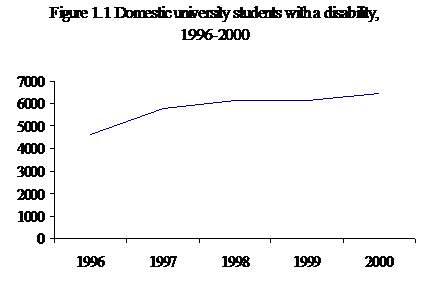
Data source: Submission No. 178, Department of
Education Science and Training, p. 22
1.35
Demographic information about the participation
of students with disabilities enrolled in universities has only been collected
since 1996 and relies on the self-identification of a disability at the time of
enrolment. Figure 1.1 shows that the number of students with disabilities
enrolled in universities has increased significantly since 1996. For the same
period the proportion of students with disabilities compared to the total
number of students has also increased from 1.9 per cent in 1996 to 3.0 per cent
in 2000. Students with disabilities show a slightly different age profile to
all other domestic students with smaller proportion of students with
disabilities under 25 and a larger proportion over 40. Almost 60 per cent of
students with disabilities identify as belonging to another equity group.[10] This group includes those from
a low socio‑economic status background, students who speak a language other than
English and have arrived in Australia within the previous ten years, indigenous
Australians, and women studying non-traditional courses such as engineering and
architecture. The committee acknowledges that this group is very broad, but
recognises the double disadvantage that may be suffered by many students with a
disability in this sector.
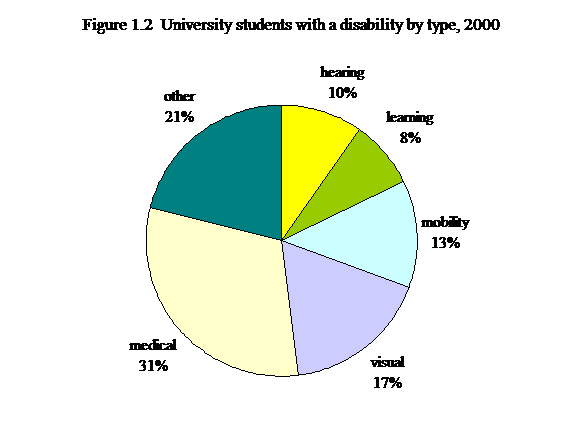
Data source: Submission No. 178, Department of
Education Science and Training, p. 22
1.36
Figure 1.2 shows the proportion of university
students with a disability by type. Medical and other disabilities account for
over half of the disabilities reported by university students. For obvious
reasons, when compared to the school sector there is a much higher proportion
of students with physical disabilities.
Vocational education and
training sector
1.37
Figure 1.3 shows the proportion of disabilities
reported by VET students in 2000. These figures, like those of the higher
education sector, rely on self-identification at the time of enrolment. The
total number of students reporting a disability increased from 47,310 in 1996,
to 62,080 in 2000.[11]
Students with disabilities tend to be older than VET students overall, with 38
per cent aged over 40 years.[12]
1.38
The VET system is able to accept, to a limited
extent, students with intellectual disabilities, and the data suggests, that a
significant number of students with intellectual disabilities do proceed to
vocational education and training.
Figure
1.3 VET students with disability by types, 2000
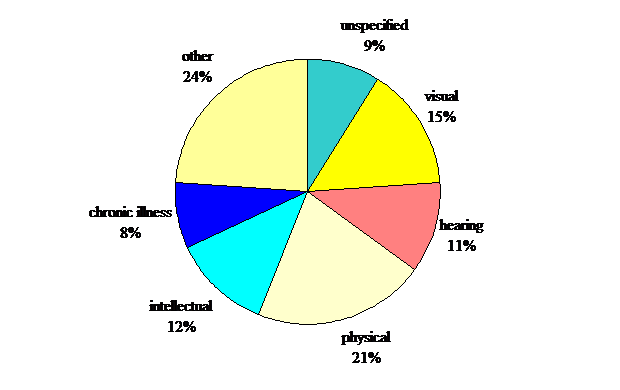
Data Source: NCVER, Australian Vocational Education
and Training Statistics, 2000, Students with a Disability in Vocational
Education and Training, p. 4
1.39
The numbers of students reporting a disability
increased from 1995 to 2000, however, as a proportion of the total VET
population the percentage of students reporting a disability increased from 2.9
per cent to 3.6 percent.[13]
Figure 1.4 VET
students reporting with a disability, 1994-2000[14]
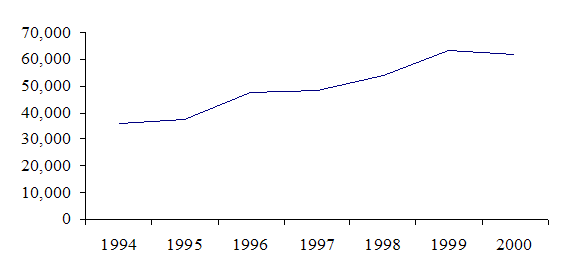
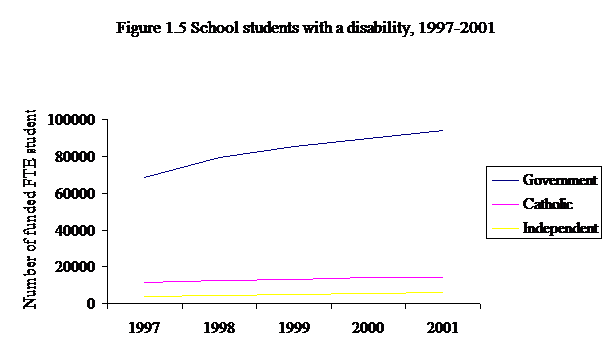
Data source: Submission 178,
Department of Education Science and Training, p.4
The school sector
1.40
Figure 1.5 shows the comparative increases in
number of students with disabilities across the government, Catholic and
independent school sectors. While all sectors show an increase in the number of
students with disabilities, the increase in absolute numbers has been greatest
in government schools. This data is collected by the Department of Education,
Science and Training and, as previously explained, does not include students
with ‘less traditional’ disabilities.
1.41
Figure 1.6 shows the percentages of disability
by type in government schools.[15]
The figures clearly illustrate the different classifications used by states.
Note in particular ‘communications–language’. The discrepancy in figures for
physical impairment are also due to the different ways in which states define
this condition. Although national comparisons based on this data need to be
accepted with caution, a number of broad observations can be made. With the
exception of South Australia, intellectual disabilities account for over half
the disabilities that receive funded support[16].
Accepting that many students with intellectual disabilities will also have a
visual, physical or hearing impairment, the data also shows the relatively low
incidence of students with visual or hearing impairments. No data is available
about the extent of less traditional disabilities, such as learning
disabilities, Aspergers Syndrome or ADHD.
Figure 1.6:
Disability by type in government schools to nearest per cent
|
|
NSW |
VIC |
TAS |
SA |
WA |
QLD |
|
Intellectual impairment
|
63
|
54
|
48
|
19
|
53
|
48
|
|
Physical impairment
|
6
|
5
|
11
|
5
|
14
|
20
|
|
Visual impairment
|
1
|
1
|
5
|
2
|
7
|
9
|
|
Hearing impairment
|
4
|
3
|
8
|
4
|
9
|
18
|
|
Communication–language
|
8
|
29
|
|
70
|
11
|
|
|
Autism
|
5
|
3
|
7
|
|
6
|
5
|
|
Mental health
|
11
|
|
1
|
|
|
|
|
Severe behavioural
|
|
5
|
|
|
|
|
|
Early learning
|
1
|
|
|
|
|
|
|
Intensive reading
|
1
|
|
|
|
|
|
|
Multiple disabilities
|
|
|
15
|
|
|
|
|
Physical disability/medical
|
|
|
5
|
|
|
|
Data source: complied from data provided by state government education
authorities.
Navigation: Previous Page | Contents | Next Page